|
|
 |
|
|
The History of the
Wildcat Uniform
Page One
1889 - 1892
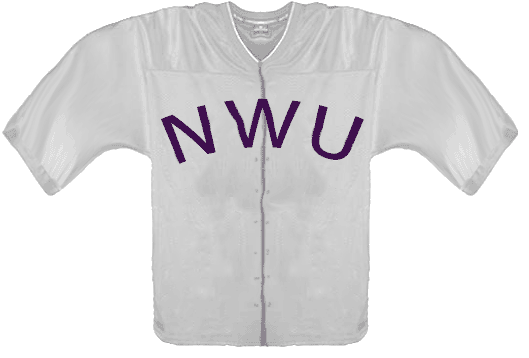
NU
began
playing football in 1876, and first fielded a varsity team 1879.
It
began intercollegiate play in 1882, but little is known of the team's
uniforms
from this period. The NU baseball team by 1875 was wearing
stylized
baseball jerseys and
"NWU"
in Old English script on the chest. By 1879 baseball uniforms
were
purple with gold trim, and the "NWU" had shifted from Old English to a
plain
block font.
SHIRT:
Little is known about what NU's football teams wore from 1876 through
1887. The 1876 team wore street clothes and did not match.
The teams from 1882 through 1887 likely wore canvas
jackets with a purple "NWU" on the chest, but it is not known for
certain. It is certain, however, that by 1888 the team was
wearing
a uniform, and it likely was the one shown above. That canvas
jacket was
definitely
used in 1889, since players wear it in the team photo. In November 1890
the team rolled out new uniforms that featured purple and gold.
During the
Nineteenth
Century, and even into the 1920s, NU's players did not all wear the
exact
same uniforms. The uniform images on this page depict the most representative
jersey worn at the time. In 1889, for instance, some players wore
the
jacket shown above, some wore a vest with "NWU" on the chest and wore a
long-sleeved
purple sweater under it, and some wore a plain white jersey.
These
jerseys continued to be worn through 1892. Also in 1892 the team began
wearing burly letter sweaters, with a large purple block "N" sown on
the
front.
HELMET:
During this
period the players did not wear helmets, though some players did wear
stocking caps. At first there was no consistency: some players
wore red caps, some purple, and one player was known for wearing a
black sombrero! By 1890 all the players wore purple and
gold-striped caps.
PANTS: In 1889 and 1890
the uniform pants were dark, likely black or purple canvas. In
1891 the team wore garish purple and white striped stockings, and in
1892,
the players wore lighter pants, likely tan.
1893 - 1897

VEST:
By 1893 the "NWU" had been dropped, and players were primarily wearing
plain purple sweaters,
with
a slate gray canvas vest over them.
In 1894 the team sweater changed, to purple with a large block "N" in
white.
This was occasionally worn in games, over the standard sweater
and
vest jersey.
PANTS: Grey, with
purple stockings.
1898
- 1899
JERSEY:
For the first time, NU wore something that actually resembled a football
jersey, rather than a baseball shirt. The 1898 jersey was
dark purple. Since separate pads had not come into circulation
yet,
the jersey itself was padded, with thick black leather quilted padding
on
the shoulders and elbows, giving the team a menacing, "Mad Max"
appearance.
PANTS: Also dark purple.
1900
- 1908
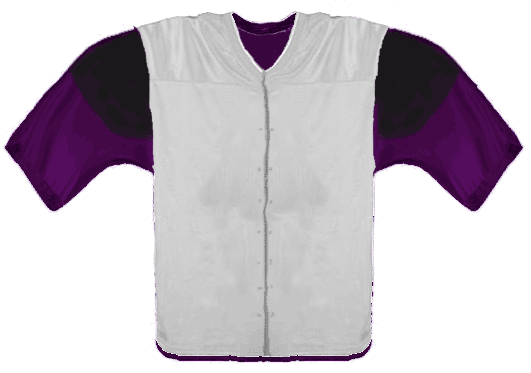
JERSEY: The 1898 jersey
now had the gray vest worn over it.
Even when NU did not field a varsity team in 1906 and 1907, the class
teams
continued to wear this uniform. In 1908, when the varsity team
returned,
they returned to wearing this style, with a lighter colored jersey
underneath
the vest.
The leather shoulder patches varied during these seasons: sometimes NU
dyed the patches black; for other seasons, the leather was a natural
brown.
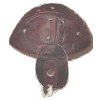
HELMET: The
team wore headgear for the first time around the turn of the century.
"Helmets"
were little more than either a leather strap with a banana shaped
receptacle
to protect the nose, or a strap with ear protectors. At first
only a few of the Purple players wore headgear. By 1905,
however,
most of the team started to wear a helmet, and the most common type was
the
"beehive" leather cap with dogflap ear protectors.
PANTS: Lighter in
color.
1909
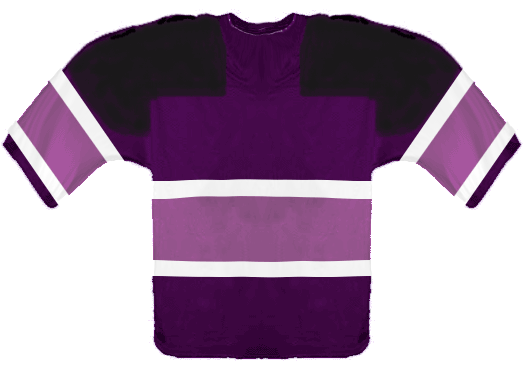
JERSEY: NU's
dramatic uniform change in 1909 marked one of the first times in
college
football that a team had a jersey with an actual design, and the
striped
pattern was a precursor to the "northwestern stripes" that NU would
develop
twenty years later.
(The colors in the illustration above are an estimate. The jersey
itself might have been black, with a purple center stripe, or the
center stripe might have been another color, such as grey or gold.)

HELMET: Same beehive
style.
PANTS: With the new
jersey, the 1909 team wore purple
pants and stockings that had the same striped pattern.
1910-1914; 1928(Purple)
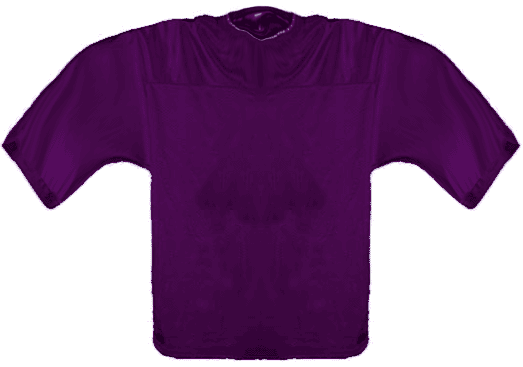
JERSEY: In 1910 NU held
onto the purple and white striped stockings, but the striped jersey was
replaced
by an absolutely plain purple jersey with long sleeves. This
style
would make a comeback for one season, in 1928.
 
HELMET: By 1912 helmets were all the more
standard "dog
flap" variety, very simple plain brown leather.
PANTS: By 1911 the
stockings were plain as well, and NU truly was the "Purple,"
decked in head to toe in nothing but.
1915; 1920-1921; 1923
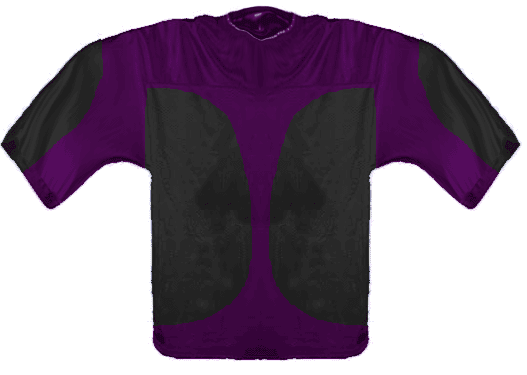
JERSEY: In 1915 NU went
back to using black leather patches on its uniforms, but now the
patches
were circular designs around the sides of the ribcage, with patches on
the
arms as well. NU
returned to the 1915 jersey style for three seasons in 1920-'21 and
1923.

HELMET: NU continued to
use the plain dogflap helmet through 1917.
PANTS: Pants remained purple, with purple
stockings.
1916-1919; 1922

The
1916 jersey
changed the patch pattern, making it more rectangular. The team
switched
back to the previous style after the 1919 season. NU then used the
rectangular
style in 1922, for the last time.
 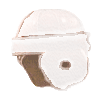 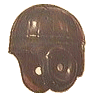
HELMET: NU stopped
wearing the small "dog flap" helmets during this time and began
wearing fuller-sized leather helmets. During 1918 most of
Northwestern's
helmets were completely painted white. By 1919 NU wore black
full-sized helmets.
1923
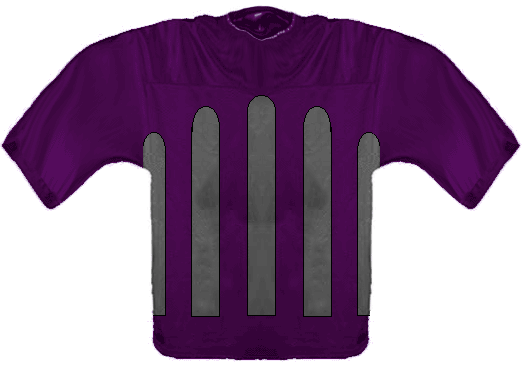
JERSEY:
The 1923 team
wore several different jerseys, including the old 1915 style and the
style
shown above. Many professional and college teams started to
employ vertical sections of fabric sewn onto the fronts of their
jerseys, in order to help the ball carrier keep his hold on the ball
(which was slightly more round in the early 1920s and more difficult to
grasp).

HELMET: Same dark
leather full-sized helmet.
1924-1927
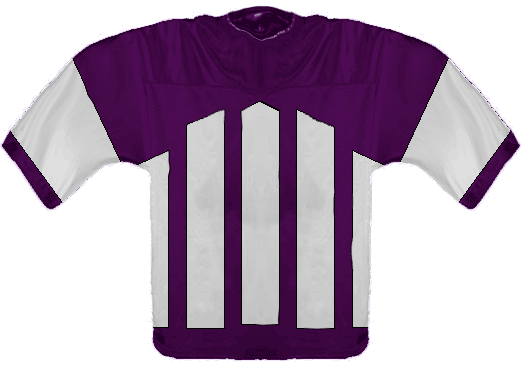
JERSEY: Switched to a dark purple
jersey with wide white vertical bars, and was worn by everyone on the
team. For games in 1927 the team wore a similar jersey, but with
black bars (not shown) instead of white.
 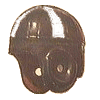 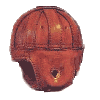
HELMET: The 'Cats
continued
to wear a plain dark helmet until 1925. During that season NU
wore
cross-hatch style black helmets with a large white cross painted on the
top.
By 1926 NU had switched to plain leather helmets, cross-hatch
style,
with no paint.
PANTS: Pants during this era were usually tan canvas. Purple stockings and black shoes were used.
1928
(White)
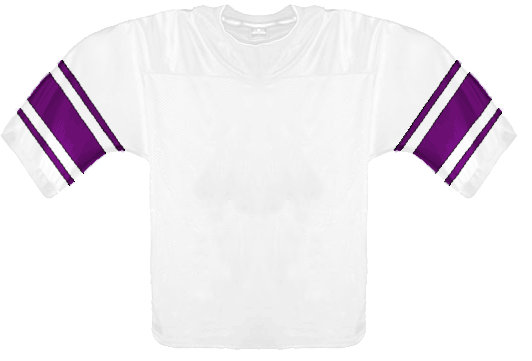
JERSEY: The breakthrough
in NU's uniform came in 1928. For the first time NU wore white
jerseys
as well as purple. Unlike today, there was no real distinction
between
white and color jerseys for home or away games; in fact, white was more
usually
worn by the Wildcats for home games.
The more significant innovation, however, was the sleeve striping for
the
white jersey. While most other colleges continued to wear plain
jerseys
or the large chest stripes, the "northwestern stripes" sleeve style on
the Wildcat
jerseys set the trend for what would become the modern college uniform. It remains one of the Wildcats' greatest
football traditions.
The
striping design (three stripes: one wide stripe enclosed by two narrow
stripes) had been around for a while. It was being used for
basketball stockings as early as 1915 and by the early 1920s it was
being used for football stockings. A handful of other football
teams had worn the pattern on their sleeves, but Northwestern's use of
the design on its jersey sleeves popularized it nationally. Within a
couple of years other teams began referring to the pattern as
"northwestern stripes." One of the earliest known references to
northwestern stripes came in 1936, when the Iowa State Teachers College
(now called the University of Northern Iowa) unveiled new basketball
warm-up suits, which featured "trousers fashioned after street pants,
[which] are of gold, with Northwestern stripes." To this day, the striping pattern is known as
"northwestern stripes."
During the 1928 season, NU also wore a purple jersey, but it was completely
plain, identical to the 1910 jersey.

HELMET: Same as
1926-1927.
PANTS: Tan pants, with
white stockings that also
had the northwestern stripes.
1929-1931(White) and 1929-1936 (Purple)

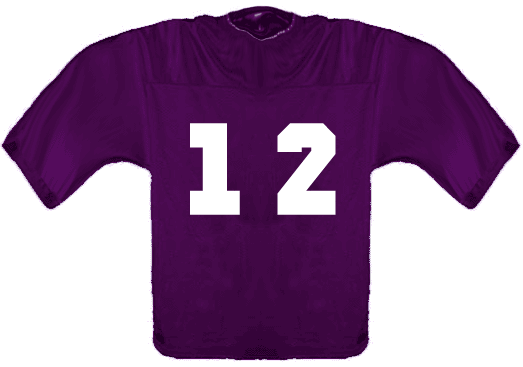
JERSEY: NU had, for some time, put
numbers on the backs of its jerseys. Now the 'Cats put numbers on
the front as well.
 
HELMET: NU's helmets
switched back from brown to black in 1930.
PANTS:
Typically tan, although for some seasons (including 1930-'31), the team
wore dark purple pants. Northwestern striped socks.
1932-1933 (White)

JERSEY: The 'Cats added
purple shoulders to their white jerseys for two seasons, giving the
uniform
a look that other teams would commonly use in the 1950s (and today in
the
NFL Europe league). The purple uniform remained without the
shoulder
panels or sleeves (although, strangely, a couple of players did use a
purple
jersey with the white shoulder panels); however, a purple jersey was
only
worn once in 1932.
In 1933 the 'Cats instead primarily wore the purple jersey.
 HELMET: No change.
HELMET: No change.


|
|
|

